The ULA Circuit Backpack is a high-capacity lightweight backpack with a surprising amount of flexibility for many types of backcountry adventures. Made with bomber 400D Robic Nylob fabric and feature-rich, the Circuit is a seriously tough pack for long backpacking trips. Perhaps more impressive is the fact that the design of the Circuit has changed very little in the past 7 years since we first reviewed it while still remaining immensely popular among female backpackers and thru-hikers backpacking longer trails such as the PCT and CDT which have fewer less frequent resupplies. The Robic Nylon Circuit reviewed here is also available in an even more durable and waterproof fabric called Ultra. See our review of the ULA Ultra24 Circuit Backpack for a detailed breakdown of its strengths and weaknesses.
RELATED:
Specs at a Glance
- Weight: 37.3 oz
- Volume: 68L
- Type: Internal Frame
- Gender: Unisex (although female-friendly S-shaped shoulder straps are available)
- Hydration-Ready: Yes (hose ports only)
- Pockets: 5
- Load Lifters: Yes
- Bear-Canister Compatibility:
- Bear canister compatibility: BV500 and Garcia fit vertically, all other Bear Vault sizes including the BV475, fit horizontally.
- Mfg. Rec’d Max Load: 35 lbs or less
- Mfg. Rec’d Base Weight: 15 lbs or less
Internal Storage and Organization
With 68 liters of total capacity, the ULA Circuit can hold a lot of gear and it’s one of the highest volume ultralight-style backpacks you can buy with few peers. Most of the pack’s storage is in a large main compartment that secures with a roll-top closure, making it easy to pack and access the gear stored inside. The advantage of a roll-top closure is that it provides excellent top compression for larger loads, without requiring any additional weight, such as a top lid, to contain the fabric in an extension collar.
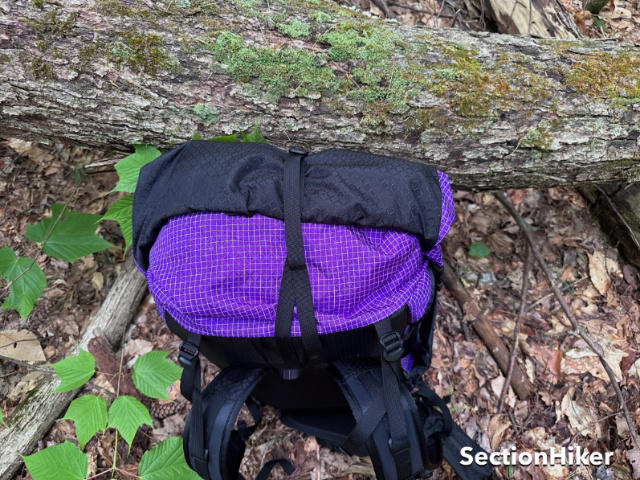
The Circuit is organized like many other lightweight and ultralight backpacks with two open side pockets, a large open rear mesh pocket, and a hip belt with two large zippered pockets. This design lets you stash all the gear and food you’re likely to need during the day on the outside of the pack, so you can avoid having to stop and dig around in your pack whenever you need something. External storage like this is the key to keeping your transition times (layer breaks, snacks, water purification, etc.) to a minimum, so you can maximize your hiking time, and mileage if you choose.

While the Circuit does have hydration ports, it does not come with an internal hydration pocket to hold a hydration system. However, there are webbing loops inside the main compartment where you can hang one and a hydration pocket is available as an add-on accessory.
The Circuit’s side pockets are large enough to store multiple bottles and deep enough so that even a 1.5-liter bottle won’t fall out. The pockets are made of solid fabric with reinforced bottoms providing excellent durability, along with drain holes so you can store wet items like water filters in them. The top of the pockets can be cinched tight with a heavy-duty elastic cord capped with a cord lock. Unfortunately, you can’t reach back and pull a bottle out of the side pockets or stow it while walking.
Comfort
Weight
Suspension
Features
Adjustability
Sizing
Durability
Excellent
Like most UL-styled packs, the Circuit has an open rear mesh pocket which is convenient for storing items you want during the day or wet items such as rain gear that you’d like to dry. The mesh pocket is surrounded by 7 fabric loops that hold an elastic cord that zigzags back and forth on the outside of the mesh pocket and is handy for securing more gear to the outside of the pack. The Circuit’s mesh pocket is made with tough fabric and can endure off-trail travel without ripping. While I still wouldn’t recommend it, I’ve done plenty of bushwhacking without tearing a hole in the mesh, which is pretty impressive.

Backpack Frame and Suspension System
The ULA Circuit is an internal frame backpack that has three structural components:
- An aluminum center stay anchored behind the lumbar region of the hipbelt
- An open fiberglass loop that runs around the top and sides of the back panel but not across the bottom
- A thin plastic frame sheet
While these three components provide enough stiffness for the Circuit to carry 30-35 pounds, they also are “soft” enough to give it a body-hugging feel that moves with you on scrambles and won’t throw you off-balance. At the same time, you have to be careful not to overstuff the Circuit (with a large sleeping winter bag, for instance) because the back frame will bow out uncomfortably and not remain flat.
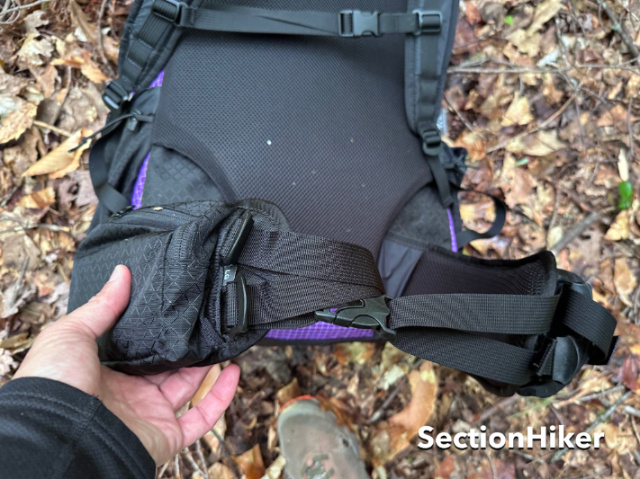
The Circuit’s hip belt is attached to the back of the pack using velcro, right in front of the point where the aluminum center stay is tied into the lumbar area. Velcro-attached hip belts are a tried and true design element on lightweight packs and are generally sufficient for up to 30-35 pound max loads. They also make it possible for you to try on different hip belt sizes with the same pack and dial in a custom fit, one of the benefits of buying a pack from ULA.
The hipbelt attaches to the backpack through a slot in the lumbar area and is secured in place using velcro. The height of the slot has about 2″ of vertical adjustability to it, so you can raise or lower the hip belt, and reduce or lengthen the torso length of the pack beyond the torso length you purchased. This is good if you’re between sizes or you need to adjust the torso length when carrying big loads.
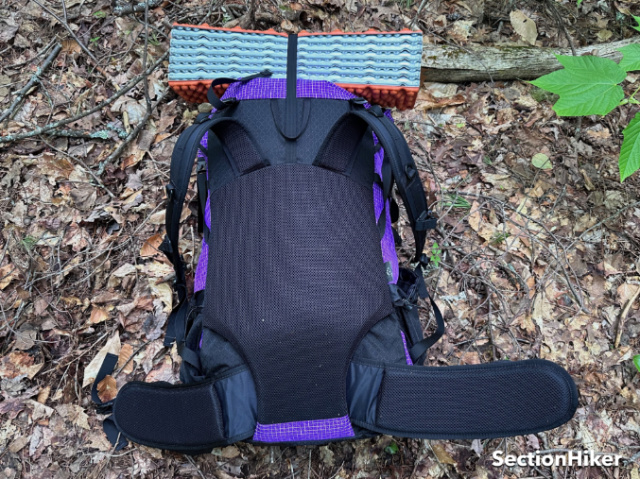
The hipbelt has two large zippered pockets and two straps that let you fine-tune the fit depending on the shape of your hips. The four straps adjust using a Scherer pull-forward cinch, first developed by Kelty, and connect at a single buckle. It can take some experimentation to get the right fit, and if you have problems, call ULA. They go above and beyond to make sure customers get an excellent fit.
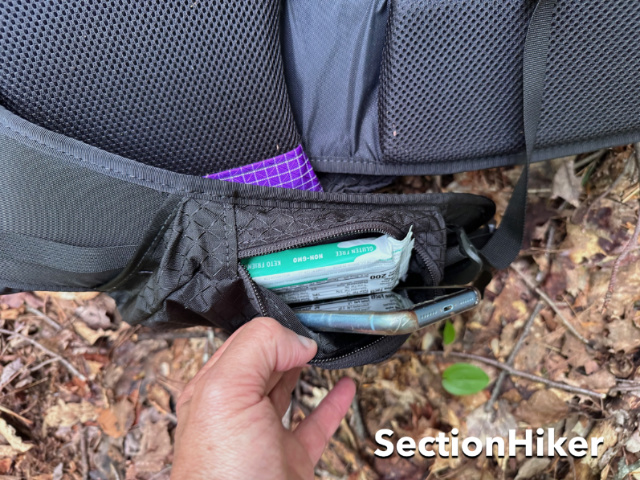
Both the hipbelt, back panel, and shoulder straps are covered in padded spacer mesh which is cushy without being too soft. The holes in the spacer mesh have a tendency to collect debris however if you wander off-trail.
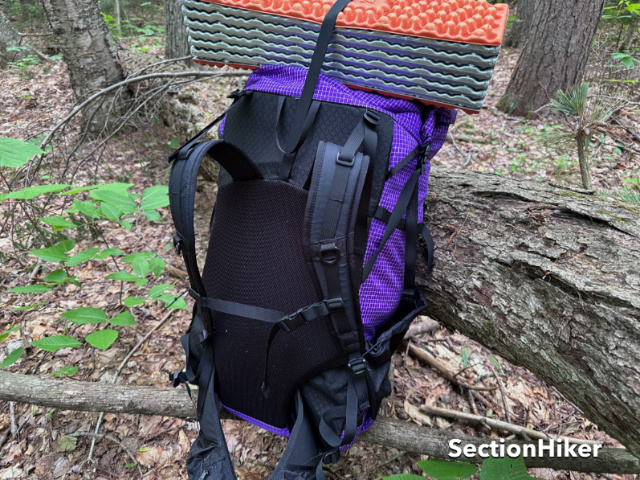
The Circuit’s shoulder straps are available in two styles, J-shaped or S-shaped, to accommodate people with breasts or wide chests, which is one of the key reasons that ULA has more female customers than any other ultralight backpack company. The shoulder straps have lots of attachment points to hang gear and front-load lifter adjustments, which slide down the front of the shoulder pad to let you adjust the angle of your load lifters if they’re too flat (a 45-degree angle is ideal). The ability to adjust the angle of the load lifters is a premium feature only found on high-end expedition or custom-made backpacks and not something normally found on lightweight or ultralight backpacks.
External Attachment Points
If you have to carry heavy and awkwardly sized gear like ice axes, rope coils, or a foam pad that won’t fit inside a backpack, it’s important to have good external attachment points that can be used to carry it on the pack’s exterior. The Circuit is somewhat weak along this dimension because it only has one tier of side compression straps, not two, and it lacks a top Y-strap. This makes it less suitable for winter backpacking than a pack with numerous external straps like the Granite Gear Blaze 60 or the Crown3 60.
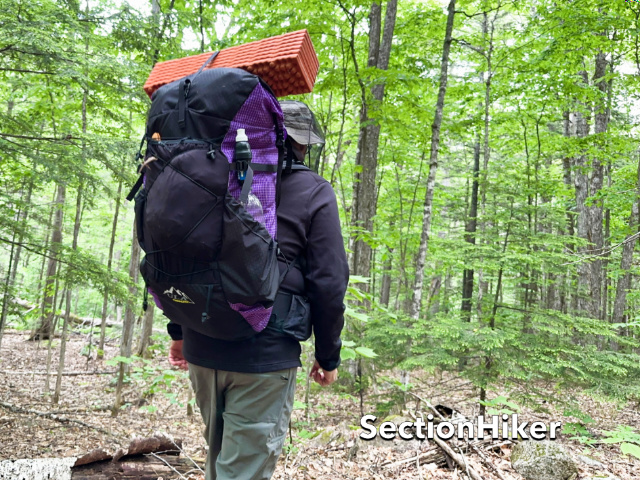
Side Compression Straps
The Circuit has one tier of side compression straps made of webbing which can be used to secure longer items to the side of the pack, such as an umbrella, a tent pole, or a taller water bottle with a sawyer filter screwed on top.
Dual Trekking Pole/Ice Axe holders
The Circuit has two trekking pole/ice axe loops including shaft holders which can be used to stow two trekking poles or ice axes.
Top Strap
A single webbing strap loops over the roll-top closure and can be used to lash a foam sleeping top to the top of the pack or a rope. It’s a little surprising that ULA has not added a Y-strap here instead, since that would provide a more secure carry for a pad or even a bear canister.
Comparable Lightweight Backpacks with Frames
Recommendation
The ULA Circuit is a high-volume lightweight backpack (68L/37.3 ounces) that’s optimally sized for weekend backpacking trips and thru-hikes. When used within its recommended load limits, the Circuit is a very comfortable backpack, with a body-hugging fit, that belies its capacity. Made with heavier, more durable fabrics (400D Robic Nylon), this is a backpack that can take some serious punishment, which makes it a best buy in my opinion if you’re looking for a high-volume ultralight-style backpack where long-lasting durability is more important.
If you’re considering purchasing a ULA Circuit the things that set it apart from other manufacturers’ backpacks are sizing and fit. If you require special sizing in terms of height or girth, or you want S-shaped shoulder straps, the Circuit or any of ULA’s other higher-volume packs are really hard to beat. The Circuit hipbelt is also best-in-class across all ultralight backpack makers and the secret sauce that makes ULA backpacks so popular, easy to carry, and well-fitting for a wide range o fusers and body shapes.
Likes
- Huge extension collar/roll-top closure provides extra volume when you need it, but rolls up and out-of-the-way when you don’t
- Solid reinforced hip belt pockets provide excellent durability
- Replaceable hip belt, with multiple sizes available for a custom fit
- Multiple shoulder strap options available, enabling unisex wear
Dislikes
- Spacer mesh on the back of the pack and hip belts pick up debris if you hike off-trail
- Back panel can bulge into your back if you overstuff the bottom of the pack’s main compartment
- Shoulder straps are anchored inside the side water bottle pockets and there’s an opening in the front of the pocket for the webbing to run through…don’t put small items in these pockets because they can fall out of this hole.
Disclosure: ULA donated a backpack for review.
Updated June, 2023.
SectionHiker is reader-supported. We only make money if you purchase a product through our affiliate links. Help us continue to test and write unsponsored and independent gear reviews, beginner FAQs, and free hiking guides.
